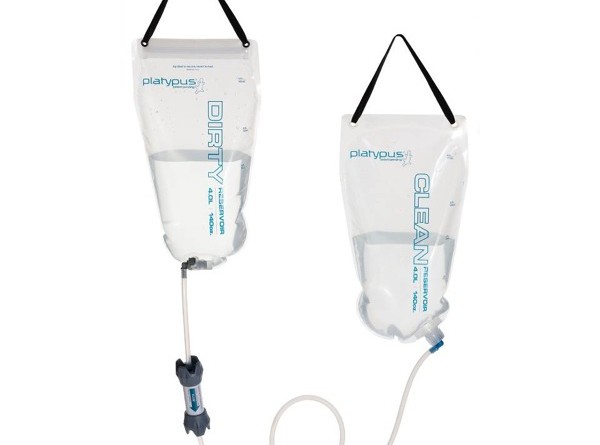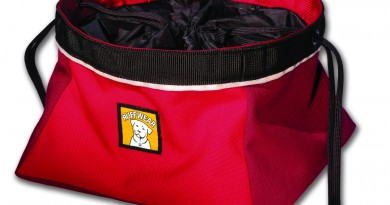Well Water | Six Better Ways to Safe Hydration in the Backcountry
One of the most important considerations to make when exploring the backcountry is planning access to safe drinking water.
Over the last decade or so, backcountry methods for water purification have come a long way. Gone are the days of tromping around with large, heavy, pump filtration systems or drinking water that looks like stagnant rust and tastes even worse. Sure, there’s nothing wrong with iodine tabs from a safety standpoint—they’ll still get the job done by killing harmful organisms most of the time. But it’s what’s not right about iodine and its limitations that has become the focus. Namely, some protozoan species have become resistant to iodine; ingesting too much iodine over time can be toxic to the body; and while iodine’s taste can be neutralized with ascorbic acid (vitamin C), it still leaves a funky taste in some people’s mouths, especially when the source of water is more on the impure side.
So to remedy these problems, manufacturers have developed improved treatment tools that not only make water safer to drink, but better tasting to boot.
THE BAD GUYS IN YOUR BEVERAGE
Before you pick your weapon, know your enemy.
Protozoa
The main concerns with these (the largest organisms causing water contamination) include Giardia lamblia (which generally causes abdominal cramps and profuse, yellow, watery, foul-smelling, explosive diarrhea, and eventually, weight loss and malnutrition) and Cryptosporidium (which typically causes copious diarrhea with mucus and can cause stomach pain and nausea and vomiting). The latter can only be treated supportively (e.g., no antibiotics) and creates a thick-walled egg or cyst that can resist some chemical treatments, even bleach and iodine sometimes.
Bacteria
Many people are familiar with the likes of E. coli and Salmonella, but a variety of others, including Staphylococcus, Shigella, Campylobacter and V. cholera can cause a variety of gastrointestinal problems and, potentially, problems in other bodily systems, as well. Luckily most are easily neutralized by almost all methods discussed in the remainder of this article.
Viruses
Rotavirus and norovirus are the main culprits here and are found relatively abundantly in any fecal contamination of drinking sources by a wide variety of animals. Virus particles are much smaller than other pathogens and are therefore somewhat harder to deal with from a water purification standpoint, particularly when it comes to filters.
Treatment Options
FILTERS
One major advantage to having a filter is that you can get all the particulate matter out of your drinking water in addition to 99.9 percent of protozoa and bacteria. The downside remains that there is still no filter that will strain out viruses. Another advantage filters have over other methods included in this article is that they generally will improve the taste of your water, are less apt to be lost or spilled than chemical methods, and require no recharge or batteries.
Platypus Gravityworks
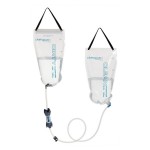 This system is pretty clever in that it is able to filter larger quantities of water without the hassle of a pumping mechanism. Simply fill up one of the bladders, hang it up, and let the water drain through the filter to a clean reservoir bladder while you pack up camp or cook breakfast. The unfortunate part: you have to do this three times, making it somewhat more tedious than other methods. While it is not supposed to remove viruses, we used it on an 11-day trek in the Himalayas without getting sick at all. And, the water had no off taste. Great for medium-sized groups.
This system is pretty clever in that it is able to filter larger quantities of water without the hassle of a pumping mechanism. Simply fill up one of the bladders, hang it up, and let the water drain through the filter to a clean reservoir bladder while you pack up camp or cook breakfast. The unfortunate part: you have to do this three times, making it somewhat more tedious than other methods. While it is not supposed to remove viruses, we used it on an 11-day trek in the Himalayas without getting sick at all. And, the water had no off taste. Great for medium-sized groups.
9.6 oz.; 10.7 oz. with case
$109.95
Aquamira Frontier Pro
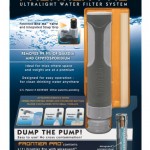 For a lone user, this is an excellent device for prefiltering water prior to chemical treatment or even for use on its own. The Frontier Pro will filter out greater than 99.9 percent of disease-causing protozoa, and most bacteria, and binds up waterborne chemicals that cause water to taste and smell bad. What’s more, it attaches to multiple tube hydration systems and many standard water bottles, and then—since it has an incorporated bite valve—can provide filtration on an on-demand basis. Or, you can just use the straw provided and drink directly from a stream or lake if you’re feeling confident about your cast-iron stomach. You can also set it up with a hydration bladder as a gravity-fed system. One filter will treat about 200 liters. I think this makes an extremely useful, lightweight, and inexpensive adjunct to chemical treatment and just about any backcountry adventure.
For a lone user, this is an excellent device for prefiltering water prior to chemical treatment or even for use on its own. The Frontier Pro will filter out greater than 99.9 percent of disease-causing protozoa, and most bacteria, and binds up waterborne chemicals that cause water to taste and smell bad. What’s more, it attaches to multiple tube hydration systems and many standard water bottles, and then—since it has an incorporated bite valve—can provide filtration on an on-demand basis. Or, you can just use the straw provided and drink directly from a stream or lake if you’re feeling confident about your cast-iron stomach. You can also set it up with a hydration bladder as a gravity-fed system. One filter will treat about 200 liters. I think this makes an extremely useful, lightweight, and inexpensive adjunct to chemical treatment and just about any backcountry adventure.
2 oz.
$24.99
CHEMICALS
While there have been some great advances from the taste and look of iodine, some people are still opposed to chemical purification because they either don’t like the idea of chemicals in their water or the taste remains unappealing. That said, these products will take care of all the GI bugs: protozoa, bacteria, and viruses alike. Combined with a filter mechanism or even a bandana to filter out larger particles, these products can’t be beat for their weight and packability. The other major advantage to these products is that their durability far surpasses any of the other products.
Aquamira Water Treatment Drops
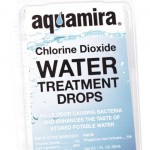 Bring two small bottles of liquid on your trip and you have enough solution to treat 2 liters of water for two people for roughly 30 days. This option provides a lot of bang for your buck, and with only a five-minute mix time, followed by a 15-minute treatment time, it’s a relatively quick option as well. Other pros: it takes up very little room in your pack, and it actually seems to make water taste better to some people. One disadvantage is that it can’t be used in sub-zero conditions at all because there is a chance the treatment drops will freeze. Otherwise, this is a pretty safe bet.
Bring two small bottles of liquid on your trip and you have enough solution to treat 2 liters of water for two people for roughly 30 days. This option provides a lot of bang for your buck, and with only a five-minute mix time, followed by a 15-minute treatment time, it’s a relatively quick option as well. Other pros: it takes up very little room in your pack, and it actually seems to make water taste better to some people. One disadvantage is that it can’t be used in sub-zero conditions at all because there is a chance the treatment drops will freeze. Otherwise, this is a pretty safe bet.
3.8 oz.
$14.99
Aquamira Water Purifier Tablets
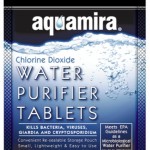 Certainly the lightest weight option, even on a per-liter basis, these tabs work well to eliminate all the baddies, with the added benefit of not having to worry about them freezing as with liquid treatments or filters. If you use these, you’d better have some good planning skills and some patience: the largest drawback is the amount of time you need to wait to safely drink the water—four hours is recommended by the manufacturer to ensure complete destruction of all Cryptosporidia. Much like the drops, the tabs seem to impart a better taste on the water to some people’s taste buds.
Certainly the lightest weight option, even on a per-liter basis, these tabs work well to eliminate all the baddies, with the added benefit of not having to worry about them freezing as with liquid treatments or filters. If you use these, you’d better have some good planning skills and some patience: the largest drawback is the amount of time you need to wait to safely drink the water—four hours is recommended by the manufacturer to ensure complete destruction of all Cryptosporidia. Much like the drops, the tabs seem to impart a better taste on the water to some people’s taste buds.
0.3 oz. for 12 tablets
$7.99 for 12 tablets
ULTRAVIOLET LIGHT
The latest and possibly greatest type of purification, ultraviolet light renders all potential pathogens incapable of reproducing (and therefore infecting you), all in a relatively short amount of time. The most significant disadvantage to these products is their fragility and need for recharge. The latter can be solved with a solar charging device, but this of course adds even more weight to your pack. UV treatments won’t do anything in terms of making your water taste or smell any better, either.
SteriPEN Freedom
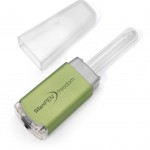 This cool gadget, about the size and shape of a jar of nail polish, will sterilize a liter of water in just over a minute-and-a-half and will treat 40 liters on a full charge. The other great thing: the Freedom is rechargeable, so if you bring a solar charger you can purify water until the bulb burns out (up to 4,000 liters). A major drawback of this product is that it will not fit in small-mouthed drinking bottles, like Platypus’ Soft Bottles, so the user is stuck using either a hydration system or wider-mouthed containers. SteriPEN also incorporates a flashlight into this device that can be turned on and off by turning the product in your hand three times like a doorknob. This feature is more than a little finicky, though.
This cool gadget, about the size and shape of a jar of nail polish, will sterilize a liter of water in just over a minute-and-a-half and will treat 40 liters on a full charge. The other great thing: the Freedom is rechargeable, so if you bring a solar charger you can purify water until the bulb burns out (up to 4,000 liters). A major drawback of this product is that it will not fit in small-mouthed drinking bottles, like Platypus’ Soft Bottles, so the user is stuck using either a hydration system or wider-mouthed containers. SteriPEN also incorporates a flashlight into this device that can be turned on and off by turning the product in your hand three times like a doorknob. This feature is more than a little finicky, though.
2.7 oz.; 3.5 oz. with case; 7.3 oz. with case, cable, and adaptor
$119.95
Camelbak All Clear
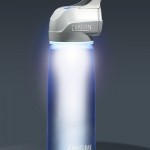 Similar to the SteriPEN, this brand-new product from Camelbak inactivates every microscopic organism or particle with an ultraviolet light housed in a special water bottle cap—in this case, at a rate of about 80 seconds per liter. Also, one full charge will treat 60 liters, making it that much more usable for slightly longer trips or more people. This product is rechargeable, with a bulb lasting up to 7,500 liters. Unfortunately, the cap only works with Camelbak bottles, so if you want to use any other type of system, you’ll have to bring along at least one Camelbak bottle and then transfer the water to your preferred reservoir. Note also that the All Clear will not treat the threads of the bottle, so you need to be circumspect about wiping the mouth of the bottle clean before drinking directly from it.
Similar to the SteriPEN, this brand-new product from Camelbak inactivates every microscopic organism or particle with an ultraviolet light housed in a special water bottle cap—in this case, at a rate of about 80 seconds per liter. Also, one full charge will treat 60 liters, making it that much more usable for slightly longer trips or more people. This product is rechargeable, with a bulb lasting up to 7,500 liters. Unfortunately, the cap only works with Camelbak bottles, so if you want to use any other type of system, you’ll have to bring along at least one Camelbak bottle and then transfer the water to your preferred reservoir. Note also that the All Clear will not treat the threads of the bottle, so you need to be circumspect about wiping the mouth of the bottle clean before drinking directly from it.
7.1 oz.; 8.4 oz. with case; 12.2 oz. with case, cable, and adaptor
$99

